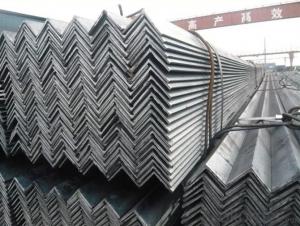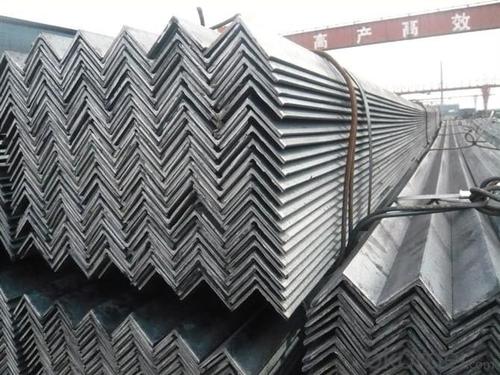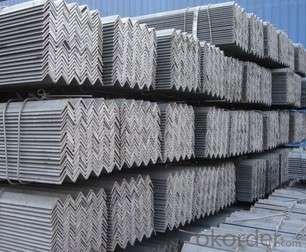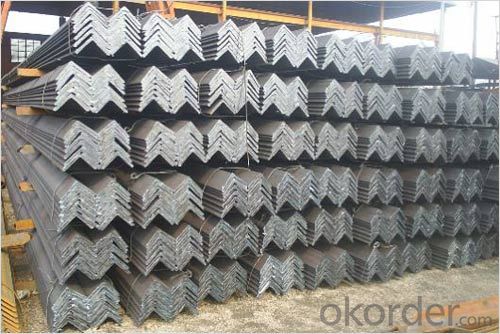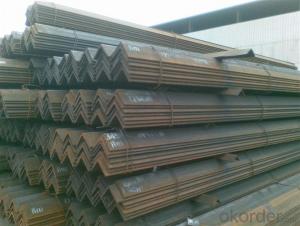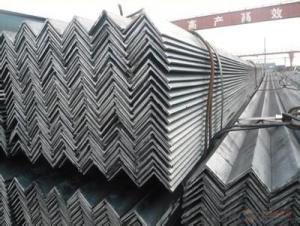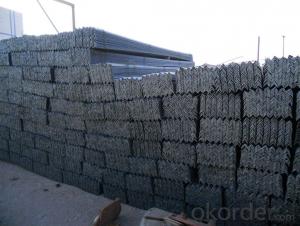Q235 Material High Quality Angle Steel
- Loading Port:
- Tianjin
- Payment Terms:
- TT or LC
- Min Order Qty:
- 25 m.t.
- Supply Capability:
- 2000 m.t./month
OKorder Service Pledge
OKorder Financial Service
You Might Also Like
Product Description:
OKorder is offering Angle Steel great prices with worldwide shipping. Our supplier is a world-class manufacturer of steel, with our products utilized the world over. OKorder annually supplies products to European, North American and Asian markets. We provide quotations within 24 hours of receiving an inquiry and guarantee competitive prices.
Product Applications:
According to the needs of different structures, Angle can compose to different force support component, and also can be the connections between components. It is widely used in various building structures and engineering structures such as roof beams, bridges, transmission towers, hoisting machinery and transport machinery, ships, industrial furnaces, reaction tower, container frame and warehouse etc.
Product Advantages:
OKorder's Angle Steelare durable, strong, and resist corrosion.
Main Product Features:
· Premium quality
· Prompt delivery & seaworthy packing (30 days after receiving deposit)
· Corrosion resistance
· Can be recycled and reused
· Mill test certification
· Professional Service
· Competitive pricing
Product Specifications:
1. Invoicing on theoretical weight or actual weight as customer request
2. Length: 6m, 9m, 12m as following table
3. Sizes
Sizes: 25mm-250mm | ||
a*t | ||
25*2.5-4.0 | 70*6.0-9.0 | 130*9.0-15 |
30*2.5-6.6 | 75*6.0-9.0 | 140*10-14 |
36*3.0-5.0 | 80*5.0-10 | 150*10-20 |
38*2.3-6.0 | 90*7.0-10 | 160*10-16 |
40*3.0-5.0 | 100*6.0-12 | 175*12-15 |
45*4.0-6.0 | 110*8.0-10 | 180*12-18 |
50*4.0-6.0 | 120*6.0-15 | 200*14-25 |
60*4.0-8.0 | 125*8.0-14 | 250*25 |
Alloy No | Grade | Element (%) | |||||
C | Mn | S | P | Si | |||
|
|
|
|
|
|
| |
Q235 | B | 0.12—0.20 | 0.3—0.7 | ≤0.045 | ≤0.045 | ≤0.3 | |
|
|
|
|
|
|
| |
Alloy No | Grade | Yielding strength point( Mpa) | |||||
Thickness (mm) | |||||||
≤16 | >16--40 | >40--60 | >60--100 | ||||
≥ | |||||||
|
|
|
|
|
| ||
Q235 | B | 235 | 225 | 215 | 205 | ||
Alloy No | Grade | Tensile strength (Mpa) | Elongation after fracture (%) | ||||
Thickness (mm) | |||||||
| ≤16 | >16--40 | >40--60 | >60--100 | |||
≥ | |||||||
|
|
|
|
|
|
| |
Q235 | B | 375--500 | 26 | 25 | 24 | 23 | |
Production Flow of High Quality Round Bar
The common processes are preheated forging quenching, dual refinement solution process, cooling quenching and isothermal quenching. We use heat treatment for dual refinement solution process. The main measures process is high temperature solution and refinement cycle. High temperature solution can improve the carbide morphology and particle size. The aim is to make the loop refinement ultrafine austenite grains.
FAQ:
Q1: Why buy Materials & Equipment from OKorder.com?
A1: All products offered byOKorder.com are carefully selected from China's most reliable manufacturing enterprises. Through its ISO certifications, OKorder.com adheres to the highest standards and a commitment to supply chain safety and customer satisfaction.
Q2: How do we guarantee the quality of our products?
A2: We have established an advanced quality management system which conducts strict quality tests at every step, from raw materials to the final product. At the same time, we provide extensive follow-up service assurances as required.
Q3: How soon can we receive the product after purchase?
A3: Within three days of placing an order, we will begin production. The specific shipping date is dependent upon international and government factors, but is typically 7 to 10 workdays.
Images:
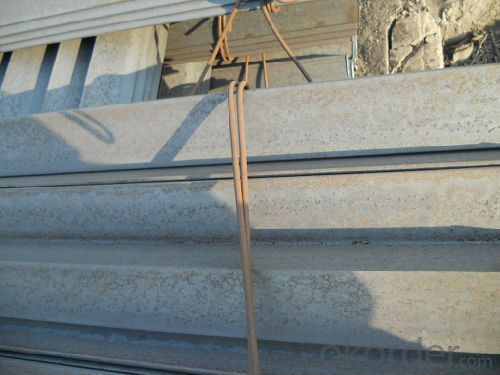
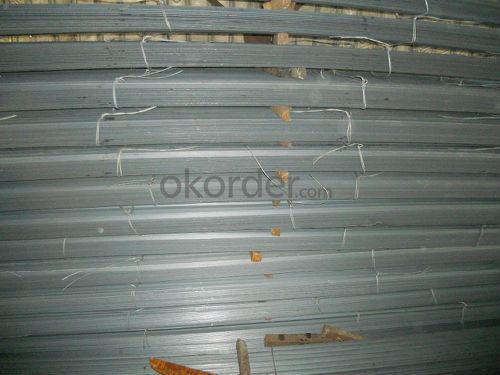
- Q: Can steel angles be customized or fabricated to specific requirements?
- Yes, steel angles can be customized or fabricated to specific requirements.
- Q: Can steel angles be used in sign support structures?
- Yes, steel angles can be used in sign support structures. Steel angles are commonly used in construction as they provide excellent strength and structural support. They can be easily welded or bolted together to form sturdy sign support structures that can withstand various weather conditions and loads.
- Q: How do you protect steel angles from moisture?
- Steel angles can be protected from moisture by applying a suitable coating or paint that acts as a barrier against moisture. Additionally, regular inspection and maintenance, including the removal of any rust or corrosion, can help prevent moisture damage.
- Q: What are the different methods of surface painting for steel angles?
- There are several different methods of surface painting for steel angles, each offering unique benefits and considerations. 1. Brushing: This is the most common method of surface painting for steel angles. It involves using a paintbrush to manually apply paint onto the surface. Brushing allows for good control and precision, making it ideal for smaller projects or touch-ups. However, it may not be as efficient for large-scale applications. 2. Spraying: Spraying is a popular method for painting steel angles, especially when a large area needs to be covered quickly. It involves using a paint spray gun or aerosol canister to evenly distribute paint onto the surface. Spraying allows for a smooth and uniform finish, but it requires appropriate safety precautions, such as wearing a mask and ensuring proper ventilation. 3. Dipping: Dipping involves immersing the steel angles in a tank or container filled with paint. This method ensures complete coverage and is often used for high-volume production processes. However, it may not be suitable for complex shapes or angles with intricate designs, as the excess paint may drip or accumulate unevenly. 4. Electrostatic painting: Electrostatic painting is a method that involves charging the paint particles and applying them to a grounded steel angle. This creates an electromagnetic attraction, resulting in a more even and efficient coverage. Electrostatic painting is commonly used in industrial settings and can help reduce paint waste and overspray. 5. Powder coating: Powder coating is a dry finishing process that involves applying a fine powder onto the steel angle's surface. The powder is then heated and fused onto the metal, creating a durable and attractive finish. Powder coating provides excellent corrosion resistance and can be done in a variety of colors and textures. However, it requires specialized equipment and may not be suitable for small-scale or on-site applications. When selecting a method of surface painting for steel angles, it is important to consider factors such as the size and complexity of the project, desired finish quality, environmental conditions, and available resources. Consulting with a professional painter or coating specialist can help determine the most suitable method for a specific application.
- Q: Can steel angles be used for fencing?
- Yes, steel angles can be used for fencing. Steel angles are commonly used in fencing applications due to their strength, durability, and versatility. They provide a sturdy framework for the fence, ensuring stability and security. Steel angles can be easily installed, and their design allows for different fence styles and heights. Additionally, they are resistant to rust and corrosion, making them suitable for outdoor use. Overall, steel angles are a popular choice for fencing projects due to their structural integrity and long-lasting performance.
- Q: What is the maximum length for a steel angle?
- The maximum length for a steel angle can vary depending on the specific type and size of the angle, as well as the manufacturing capabilities of the steel supplier. Generally, steel angles are available in standard lengths ranging from 20 feet to 40 feet. However, longer lengths may be possible through custom orders or special production processes. It is recommended to consult with a steel supplier or manufacturer to determine the maximum length that is readily available or can be obtained for a specific type of steel angle.
- Q: What are the different types of steel angle profiles?
- There are several different types of steel angle profiles, including equal angle, unequal angle, L-shaped angle, and structural angle. Each profile has its own specific dimensions and uses in various applications.
- Q: What are the different surface finishes available for galvanized steel angles?
- Some of the different surface finishes available for galvanized steel angles include hot-dip galvanized, electro-galvanized, painted, and powder-coated finishes.
- Q: How do steel angles perform under static or stationary loading conditions?
- Steel angles are widely utilized in construction and engineering due to their strength and versatility. They exhibit excellent performance and stability when subjected to static or stationary loading. In the case of static loading, the angle remains motionless while a load is applied. Steel angles are specifically engineered to withstand such loading conditions. Their structural properties enable them to resist bending and twisting forces, ensuring they can effectively support heavy loads without experiencing significant deformation or failure. Moreover, steel angles evenly distribute the applied load along their length, minimizing stress concentrations. This property allows the angle to efficiently transfer the load to the supporting structure, thereby providing stability and maintaining structural integrity. Furthermore, steel angles have the ability to withstand compressive forces, which attempt to compress or shorten the material. Their L-shaped profile and cross-section contribute to their resistance against compressive loading. This characteristic makes steel angles suitable for applications where static loads exert compressive forces, such as columns, beams, and bracing elements. Additionally, steel angles possess high resistance to shear forces, which occur when different parts of a structure slide or move in opposite directions. The design of steel angles, with perpendicular legs, enhances their shear strength, enabling them to effectively resist shear loading under stationary conditions. In conclusion, steel angles demonstrate exceptional performance under static or stationary loading. Their structural properties, including resistance to bending, twisting, compression, and shear forces, make them suitable for various construction and engineering applications.
- Q: Can steel angles be used for manufacturing window frames?
- Yes, steel angles can be used for manufacturing window frames. Steel angles are commonly used in construction and manufacturing because of their strength, durability, and versatility. They provide a sturdy framework for windows and can withstand the weight and pressure of the window glass. Steel angles can be easily welded, bolted, or screwed together to create a strong and stable window frame. Additionally, steel angles can be customized to meet specific design requirements, making them suitable for various window sizes and shapes. Overall, steel angles are a popular choice for manufacturing window frames due to their reliability, strength, and adaptability.
Send your message to us
Q235 Material High Quality Angle Steel
- Loading Port:
- Tianjin
- Payment Terms:
- TT or LC
- Min Order Qty:
- 25 m.t.
- Supply Capability:
- 2000 m.t./month
OKorder Service Pledge
OKorder Financial Service
Similar products
Hot products
Hot Searches
Related keywords
